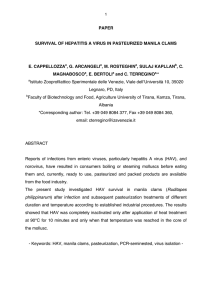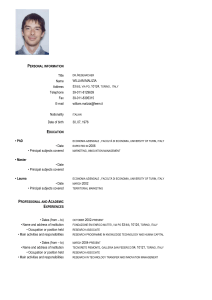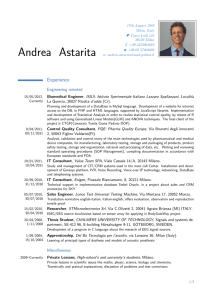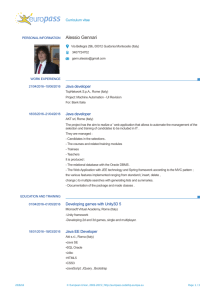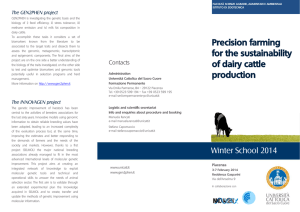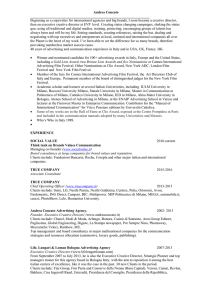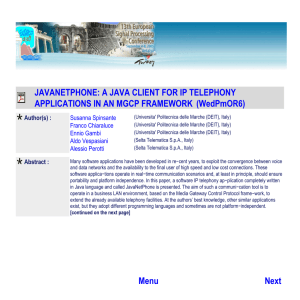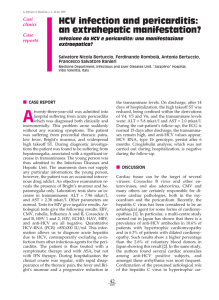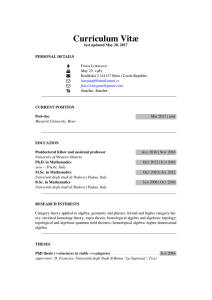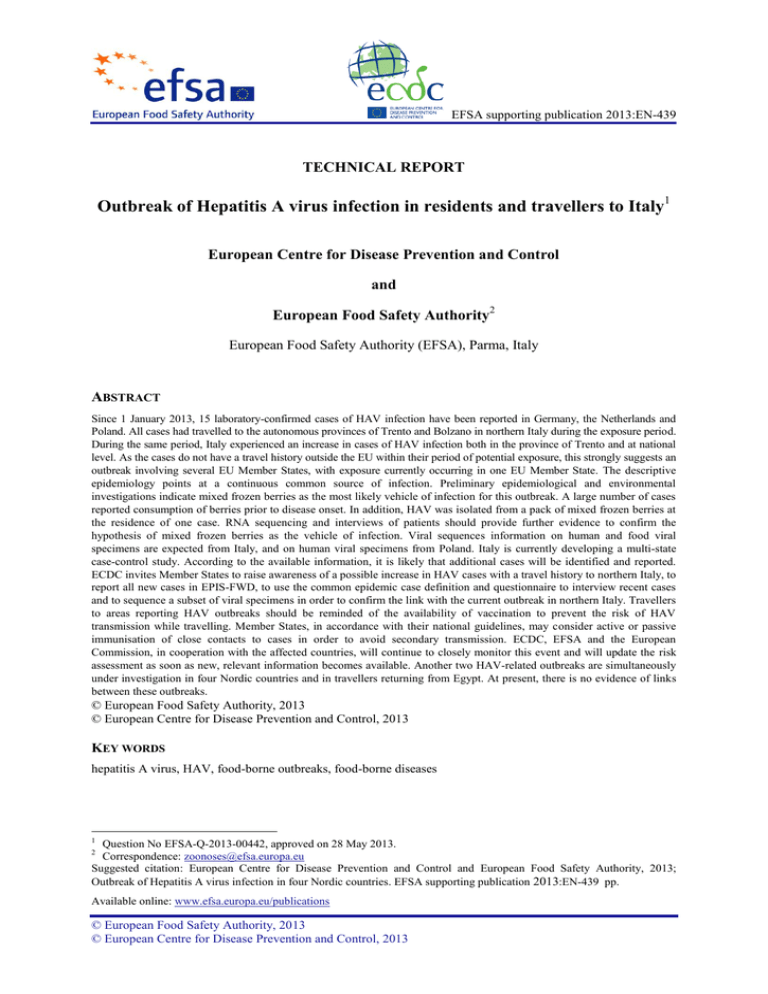
EFSA supporting publication 2013:EN-439
TECHNICAL REPORT
Outbreak of Hepatitis A virus infection in residents and travellers to Italy1
European Centre for Disease Prevention and Control
and
European Food Safety Authority2
European Food Safety Authority (EFSA), Parma, Italy
ABSTRACT
Since 1 January 2013, 15 laboratory-confirmed cases of HAV infection have been reported in Germany, the Netherlands and
Poland. All cases had travelled to the autonomous provinces of Trento and Bolzano in northern Italy during the exposure period.
During the same period, Italy experienced an increase in cases of HAV infection both in the province of Trento and at national
level. As the cases do not have a travel history outside the EU within their period of potential exposure, this strongly suggests an
outbreak involving several EU Member States, with exposure currently occurring in one EU Member State. The descriptive
epidemiology points at a continuous common source of infection. Preliminary epidemiological and environmental
investigations indicate mixed frozen berries as the most likely vehicle of infection for this outbreak. A large number of cases
reported consumption of berries prior to disease onset. In addition, HAV was isolated from a pack of mixed frozen berries at
the residence of one case. RNA sequencing and interviews of patients should provide further evidence to confirm the
hypothesis of mixed frozen berries as the vehicle of infection. Viral sequences information on human and food viral
specimens are expected from Italy, and on human viral specimens from Poland. Italy is currently developing a multi-state
case-control study. According to the available information, it is likely that additional cases will be identified and reported.
ECDC invites Member States to raise awareness of a possible increase in HAV cases with a travel history to northern Italy, to
report all new cases in EPIS-FWD, to use the common epidemic case definition and questionnaire to interview recent cases
and to sequence a subset of viral specimens in order to confirm the link with the current outbreak in northern Italy. Travellers
to areas reporting HAV outbreaks should be reminded of the availability of vaccination to prevent the risk of HAV
transmission while travelling. Member States, in accordance with their national guidelines, may consider active or passive
immunisation of close contacts to cases in order to avoid secondary transmission. ECDC, EFSA and the European
Commission, in cooperation with the affected countries, will continue to closely monitor this event and will update the risk
assessment as soon as new, relevant information becomes available. Another two HAV-related outbreaks are simultaneously
under investigation in four Nordic countries and in travellers returning from Egypt. At present, there is no evidence of links
between these outbreaks.
© European Food Safety Authority, 2013
© European Centre for Disease Prevention and Control, 2013
KEY WORDS
hepatitis A virus, HAV, food-borne outbreaks, food-borne diseases
1
Question No EFSA-Q-2013-00442, approved on 28 May 2013.
Correspondence: [email protected]
Suggested citation: European Centre for Disease Prevention and Control and European Food Safety Authority, 2013;
Outbreak of Hepatitis A virus infection in four Nordic countries. EFSA supporting publication 2013:EN-439 pp.
2
Available online: www.efsa.europa.eu/publications
© European Food Safety Authority, 2013
© European Centre for Disease Prevention and Control, 2013
RAPID OUTBREAK ASSESSMENT
Outbreak of hepatitis A virus infection
in residents and travellers to Italy
28 May 2013
Summary
•
•
•
•
•
•
•
Since 1 January 2013, 15 laboratory-confirmed cases of HAV infection have been reported in Germany, the
Netherlands and Poland. All cases had travelled to the autonomous provinces of Trento and Bolzano in
northern Italy during the exposure period. During the same period, Italy experienced an increase in cases
of HAV infection both in the province of Trento and at national level. As the cases do not have a travel
history outside the EU within their period of potential exposure, this strongly suggests an outbreak
involving several EU Member States, with exposure currently occurring in one EU Member State.
The descriptive epidemiology points at a continuous common source of infection. Preliminary
epidemiological and environmental investigations indicate mixed frozen berries as the most likely vehicle
of infection for this outbreak.
A large number of cases reported consumption of berries prior to disease onset. In addition, HAV was
isolated from a pack of mixed frozen berries at the residence of one case. RNA sequencing and
interviews of patients should provide further evidence to confirm the hypothesis of mixed frozen berries
as the vehicle of infection. Viral sequences information on human and food viral specimens are expected
from Italy, and on human viral specimens from Poland. Italy is currently developing a multi-state casecontrol study.
According to the available information, it is likely that additional cases will be identified and reported.
ECDC invites Member States to raise awareness of a possible increase in HAV cases with a travel history
to northern Italy, to report all new cases in EPIS-FWD, to use the common epidemic case definition and
questionnaire to interview recent cases and to sequence a subset of viral specimens in order to confirm
the link with the current outbreak in northern Italy.
Travellers to areas reporting HAV outbreaks should be reminded of the availability of vaccination to
prevent the risk of HAV transmission while travelling. Member States, in accordance with their national
guidelines, may consider active or passive immunisation of close contacts to cases in order to avoid
secondary transmission.
ECDC, EFSA and the European Commission, in cooperation with the affected countries, will continue to
closely monitor this event and will update the risk assessment as soon as new, relevant information
becomes available.
Another two HAV-related outbreaks are simultaneously under investigation in four Nordic countries and
in travellers returning from Egypt. At present, there is no evidence of links between these outbreaks.
© European Centre for Disease Prevention and Control, Stockholm, 2013
RAPID OUTBREAK ASSESSMENT
Outbreak of hepatitis A virus in Italy, 28 May 2013
Public health issue
Outbreak of hepatitis A virus infection (HAV) in residents of Italy and travellers to Italy from Germany, Poland and
the Netherlands.
Source and date of request
ECDC Round Table, 22 May 2013.
Consulted experts
ECDC internal response team
Ettore Severi, Emmanuel Robesyn, Jaime Martinez Urtaza, Dragoslav Domanovic, Celine Gossner, Johanna
Takkinen.
EFSA experts
Ernesto Liebana and Pia Mäkelä.
External experts consulted and acknowledged
Mirko Faber (Robert Koch-Institute, Germany), Linda Verhoef (National Institute for Public Health and the
Environment-RIVM, the Netherlands); Anna Baumann-Popczyk and Malgorzata Sadkowska-Todys (National
Institute of Public Health and National Institute of Hygiene, Poland).
ECDC and EFSA acknowledge the valuable contributions from the above-mentioned experts and institutions. All
experts have signed a Declaration of Interest. Opinions expressed by individual experts do not necessarily
represent the opinion of their institutions.
Disease background information
HAV is a small, non-enveloped hepatotropic virus classified in the genus Hepatovirus within the family
Picornaviridae. Its genome consists of a 7 500-nucleotide linear, positive-stranded RNA. Genotypes have been
traditionally defined based on analysis of a 168-nucleotide segment of the VP1-2A region. Based on this sequence,
six HAV genotypes, I to VI, have been defined. Genotypes I, II and III, divided into subtypes A and B, infect
humans. Data on genotype distribution showed that genotype I was the most prevalent worldwide, with IA being
reported more frequently than IB, and that sub-genotype IIIA was prevalent in Central Asia. In areas of low
endemicity, such as the United States and Western Europe, sub-genotype IA dominates, but all genotypes and
subtypes have been reported [1].
The disease, often asymptomatic or mild, particularly in children below five years, is highly transmissible with an
average incubation period of 28 to 30 days (range 15–50 days). In adults, the onset of illness is usually abrupt
with fever, malaise and abdominal discomfort. Jaundice is the predominant symptom. Symptoms may last from
one or two weeks to months. Prolonged, relapsing hepatitis for up to one year occurs in 15% of cases. No chronic
infection is known to occur and infection confers lifelong immunity [2].
The case-fatality ratio is low (0.1–0.3%) but might be higher (1.8%) in adults over 50 years of age or persons with
underlying chronic liver disease [2, 3]. The maximum infectivity is in the second half of the incubation period (i.e.
while asymptomatic) and most cases are considered non-infectious after the first week of jaundice.
HAV can be transmitted through contaminated water, food and via faecal-oral route among close contacts (e.g.
household contacts, sexual contacts, in day care centres or schools [4-6]). The following risk factors or risk groups
have also been associated with illness in outbreaks: use of contaminated blood products [7], people who inject
drugs [8-10] or use other illicit drugs [11], men having sex with men (MSM) [4], and homeless people [11, 12]. No
pharmacological treatment exists. Strict control measures, such as reinforcing personal hygiene, contact tracing
and administration of vaccine to exposed persons, have proved to be effective [13, 14]. Active (antigen) and
passive (antisera) immunisation is effective if administered within two weeks of exposure. Several inactivated
vaccines are available for prevention.
The virus is very resistant in the environment as well as to several preservation methods used in the food industry,
e.g. acidification or freezing [15-20], thus possible foodborne transmission should be investigated when cases are
reported.
2
RAPID OUTBREAK ASSESSMENT
Outbreak of hepatitis A virus in Italy, 28 May 2013
The notification rate in the EU for HAV has been steadily decreasing over the last 15 years, from 14.0 in 1997 to
2.6 per 100 000 population in 2010 [21, 22], despite some countries still experiencing high notification rates. This
most likely reflects improved living conditions, as HAV seroprevalence rates are strongly correlated with
socioeconomic status and access to clean water and sanitation [23].
The highest notification rates in the EU are reported among the young under 15 years old [22]. There is a marked
seasonal pattern with a peak in the autumn, which may reflect increases following travel to endemic countries
during summer holidays [22]. The low incidence in the EU populations can result in a high proportion of susceptible
individuals if vaccination coverage is low. If the infection is then introduced, there is a risk that adolescents and
young adults will be infected who have not been vaccinated or were not infected at an early age.
Food-borne transmission of HAV has been implicated in several outbreaks in recent years. Between 2007 and
2011, EFSA and ECDC reported 11 outbreaks with strong evidence of hepatitis A as the causative agent. The food
vehicles responsible were: fish and seafood products (crustaceans, shellfish, molluscs and products containing
these), sandwiches, vegetables, juices and semi-dried tomatoes [24-28]. In addition, minimally processed food
products may be at the origin of foodborne outbreaks. For example, France reported an HAV infection outbreak
involving 59 cases where frozen semi-dried tomatoes were identified as the vehicle of infection in all primary cases
[29]. Semi-dried tomatoes were also implicated in an outbreak involving 144 HAV cases in Australia in 2009 [30]
and were suspected in a cluster of cases in the UK in 2011 [31]. In several outbreaks associated with fresh
products, food handlers involved in harvesting or preparing foods have been identified as the source [32]. For
example, in 2004, an outbreak of 269 cases detected in Belgium was associated with the consumption of raw beef,
traced back to an infected food handler in a distribution plant [33].
In August and November 2012, the Netherlands reported two clusters of HAV sub-genotype IA infection with a
large proportion of cases exposed to strawberries (urgent inquiry in EPIS-FWD). Berries were also implicated in
HAV infection outbreaks in 1987 – 24 HAV cases, associated with consumption of frozen raspberries, were reported
in Scotland, UK [34]; and in 1997 – an outbreak affecting 153 people associated with consumption of frozen
strawberries, was reported in Michigan, USA [35]. In 2004, orange juice was implicated in a large outbreak with
more than 300 cases of HAV infection in travellers from nine European countries returning from Egypt [36].
According to the Rapid Alert System for Food and Feed (RASFF) database, 21 samples of food were found to be
contaminated with HAV between 1999 and 2013. HAV was found in six EU countries (Belgium, Czech Republic,
Germany, Italy, the Netherlands and Spain) in the following food items: shellfish (e.g. oysters, mussels, clams and
scallops), semi-dried tomatoes, dates, frozen strawberries, strawberry yoghurt cake and frozen berry mix.
Event background information
Results of the epidemiological and microbiological
investigations
On 8 May 2013, Germany reported in EPIS-FWD and EWRS, seven cases of HAV infection in persons with a travel
history to ski resorts in the autonomous provinces of Trento and Bolzano in northern Italy.
Following the German report, the Netherlands and Poland reported additional HAV cases, one and five respectively,
with a travel history to different villages and hotels in the province of Trento. Following the alert, Italy reported 26
HAV cases in 2013 in the province of Trento, 11 of which were reported in May. No HAV cases had been reported
in the same province in the previous two years. Italy also reports a 70% increase in HAV notifications at national
level between March and May 2013 compared to the same months in 2012. Germany reported two additional cases
on 21 and 24 May; both cases had travelled to the province of Bolzano.
ECDC, in collaboration with the affected Member States, prepared a case definition for this outbreak (see Annex).
The cases from Germany, Poland and the Netherlands had visited Italy between late February and mid-April, with
most cases visiting around mid-March. The time of disease onset ranged from late March to early May. The cases
had stayed in at least six different villages in the provinces of Trento and Bolzano. Local authorities visited the
accommodation reported by these cases and interviewed the staff. The hotels are currently closed due to the midseason break. Information on food items distributed is under analysis.
Preliminary information from some of the cases reported in Italy shows either a history of travel to the provinces of
Trento and Bolzano, or consumption of frozen mixed berries as potential risk factors. Four Italian cases, who
attended a private dinner in north-eastern Italy, reported consumption of berries. HAV was identified in mixed
berries found in the freezer at the residence of the case that prepared the dinner.
Both human and food laboratory investigations are underway to define the genotype and sequence of the hepatitis
A virus involved in human and in food samples.
3
RAPID OUTBREAK ASSESSMENT
Outbreak of hepatitis A virus in Italy, 28 May 2013
Information on genotype and sequence is currently available only for the Dutch case. The case was associated with
the sub-genotype IA and the sequence is available on EPIS-FWD or from ECDC upon request. This case did not
report having eaten berries during the visit to Italy.
As of 24 May 2013, 41 cases of hepatitis A have been reported associated with the provinces of Trento and
Bolzano: nine in Germany, five in Poland, one in the Netherlands and 26 in Italy, in the province of Trento.
Other information
There are currently two additional outbreaks of HAV affecting EU/EEA countries. The first is on-going in four Nordic
countries [37] and imported frozen strawberries are the suspected vehicle of infection. The second outbreak
involves travellers returning from Egypt to several European countries [38]; foodborne transmission is suspected,
but no specific food item has been implicated to date. These two, so far unrelated outbreaks have been found to
be associated with unique outbreak strains. At present, no similar strains have been identified in the outbreak
affecting the north of Italy.
In November 2012, two RASFF notifications involved strawberries:
Notification 2012.1603 from Germany: hepatitis A virus in strawberry yoghurt cake from Germany.
Notification 2012.1534 from Belgium: hepatitis A virus in frozen strawberry cubes from China.
A sample of the contaminated frozen strawberries from China was shared by the Belgian food authorities with the
Dutch public health laboratory for sequencing, but the virus could not be isolated for further typing.
On 17 May 2013, a RASFF notification (notification 2013.0694) was sent out by Italian food authorities regarding
the mixed frozen berries found to be contaminated with HAV in north-eastern Italy. The frozen berry mix
originated from Italy, with raw berry material from Poland, Bulgaria, Canada and Serbia. Following the notification,
the distributor of the mixed frozen berries voluntarily withdrew these from the national market. Investigation into
the traceability of the product is currently underway.
Threat assessment for the EU
An outbreak of HAV infections has been reported among travellers to different villages in the provinces of Trento
and Bolzano, northern Italy, from Germany, Poland and the Netherlands. Italy is reporting an increase in HAV
notifications, both in the province of Trento and at national level since the beginning of 2013.
The distribution of symptom onset over time suggests a common, continuous source outbreak with the majority of
the non-Italian cases infected around mid-March. The most recent cases have been reported by Germany, Italy
and Poland with onset of symptoms in early May, indicating that the outbreak is still on-going. Considering the
delay in case reporting and the on average one-month-long incubation period, more cases are expected to be
reported.
The consumption of berries reported by many of the cases, the previous positive HAV findings in frozen berries and
the identification of mixed, frozen berries contaminated with HAV from the fridge of HAV cases strengthen the
hypothesis that the origin of this outbreak is food-borne.
Genotype and RNA sequence analysis of strains from human and food samples may provide additional evidence to
support the link between cases and berries. In addition, on-going epidemiological studies may provide additional
evidence to confirm the hypothesis that mixed frozen berries are the vehicle of infection in this outbreak.
The voluntary withdrawal of the mixed frozen berries by the distributor has decreased the risk of infection for
residents and visitors to northern Italy. However, the specific berry type has not yet been identified and, due to the
long shelf life of frozen berries, it is likely that a part of the initial batch may still be circulating for some time or will
be stored in household freezers. Furthermore, the point of contamination is unknown. Therefore additional HAV
cases may be expected in the coming weeks.
The current outbreak in several EU/EEA countries poses a slightly elevated risk of secondary transmission through
infected travellers after their return to their home country. Transmission through infected food handlers and
household contacts should be taken into consideration. There is also a risk of HAV transmission through
asymptomatic or incubating viraemic blood donors. In the affected area potential blood donors should be asked
standard agent-nonspecific questions to identify risk groups and agent-specific screening questions concerning a
history of possible exposure to HAV. In non-affected areas temporary questions on recent (30 days before
donation) travel history to affected areas (Trento and Bolzano) should be introduced in the blood donor
questionnaire. In the event of positive exposure and travel history donors should be tested and temporarily
deferred for one year if positive [39].
Public health and food authorities in the affected countries and ECDC are working together to identify the vehicle
of the infection in order to prevent additional cases.
4
RAPID OUTBREAK ASSESSMENT
Outbreak of hepatitis A virus in Italy, 28 May 2013
For recent cases, and should new cases arise, ECDC recommends the use of the epidemic case definition prepared
specifically for this outbreak.
ECDC is encouraging all Member States experiencing an increase in HAV cases with a travel history to the
autonomous provinces of Trento and Bolzano in northern Italy to perform HAV RNA sequencing and to compare
their results with the Dutch sequence available in EPIS-FWD.
It should be noted that the genotype and the RNA sequence of the virus isolated from the Dutch case returning
from Italy are different to the sequence type revealed for the strains isolated in the non-travel related HAV
outbreak currently affecting the Nordic countries. The same applies to the strains isolated in the outbreak
associated with travel to Egypt which is affecting several EU/EEA countries. Consequently, at this point, no link can
be established between the three simultaneous outbreaks. It is also possible, however, that the Dutch case is a
sporadic case and not linked to the current outbreak in northern Italy.
Conclusions and recommendations
Since 1 January 2013, 15 laboratory-confirmed cases of HAV infection have been reported in Germany, the
Netherlands and Poland. All cases have a travel history to the autonomous provinces of Trento and Bolzano in
northern Italy during the exposure period. During the same period, Italy experienced an increase in cases of HAV
infection, both in province of Trento and at national level. As the cases do not have a travel history outside the EU
within their period of potential exposure, this strongly suggests an outbreak involving several EU Member States,
with exposure currently occurring in one EU Member State.
The descriptive epidemiology points at a continuous common source of infection. Preliminary epidemiological and
environmental investigations indicate mixed frozen berries as the most likely vehicle of infection for this outbreak.
A large number of cases reported consumption of berries prior to disease onset. In addition HAV was isolated from
a pack of mixed frozen berries at the residence of one case. RNA sequencing and interviews of cases should
provide further evidence to confirm the hypothesis of mixed frozen berries as the vehicle of infection. Viral
sequences information on human and food viral specimens are expected from Italy, and on human viral specimens
from Poland. Italy is currently developing a multi-state case-control study.
According to the available information, it is likely that additional cases will be identified and reported. ECDC invites
Member States to raise awareness of a possible increase in HAV cases with a travel history to northern Italy, to
report all new cases in EPIS-FWD, to use the common epidemic case definition and questionnaire to interview
recent cases and to sequence a subset of viral specimens in order to confirm the link with the current outbreak in
northern Italy.
Travellers to areas reporting HAV outbreaks should be reminded of the availability of vaccination to prevent the
risk of HAV transmission while travelling. Member States, in accordance with their national guidelines, may
consider active or passive immunisation of close contacts to cases in order to avoid secondary transmission.
ECDC, EFSA and the European Commission, in cooperation with the affected countries, will continue to closely
monitor this event and will update the risk assessment as soon as new relevant information becomes available.
Two other HAV-related outbreaks are simultaneously under investigation in four Nordic countries and in travellers
returning from Egypt. At present, there is no evidence of links between these outbreaks.
Contact
For further information, please send an e-mail to: [email protected]
5
RAPID OUTBREAK ASSESSMENT
Outbreak of hepatitis A virus in Italy, 28 May 2013
References
1.
Desbois D, et al. Epidemiology and genetic characterization of hepatitis A virus genotype IIA . J
Clin Microbiol 2010. 48(9):3306-15.
2.
Heymann D. Control of communicable diseases manual, 18th edition, Official report of the
American Public Health Association. 2008.
3.
Koff RS. Hepatitis A. Lancet 1998. 351(9116):1643-9.
4.
Blystad H, Stene-Johansen K, Steen T. Hepatitis A outbreak in men who have sex with men,
Oslo and Bergen in Norway. Euro Surveill 2004. 8(43).
5.
Hanna JN, et al. Recognising and responding to outbreaks of hepatitis A associated with child
day-care centres. Aust N Z J Public Health, 2001. 25(6):525-8.
6.
Pebody RG, et al. Foodborne outbreaks of hepatitis A in a low endemic country: an emerging
problem? Epidemiol Infect 1998. 120(1):55-9.
7.
Vonberg RP, Gastmeier P. Hospital-acquired infections related to contaminated substances.
J Hosp Infect 2007. 65(1):15-23.
8.
Ngui SL, et al. Outbreaks of hepatitis A in England and Wales associated with two co-circulating
hepatitis A virus strains. J Med Virol 2008. 80(7):1181-8.
9.
O'Donovan D, et al. An outbreak of hepatitis A amongst injecting drug users. Epidemiol Infect
2001. 127(3): 469-73.
10.
Widell A, et al. Increased occurrence of hepatitis A with cyclic outbreaks among drug addicts in
a Swedish community. Infection 1983. 11(4):198-200.
11.
James TL, et al. Response to hepatitis A epidemic: emergency department collaboration with
public health commission. J Emerg Med 2009. 36(4):412-6.
12.
Tjon GM, et al. An outbreak of hepatitis A among homeless drug users in Rotterdam, The
Netherlands. J Med Virol 2005. 77(3):360-6.
13.
Latimer WW, et al. Prevalence and correlates of hepatitis A among adult drug users: the
significance of incarceration and race/ethnicity. Vaccine 2007. 25(41):7125-31.
14.
Sunthornchart S, et al. Prevalence of hepatitis B, tetanus, hepatitis A, human immunodeficiency
virus and feasibility of vaccine delivery among injecting drug users in Bangkok, Thailand, 2003–
2005. Addiction 2008. 103(10):1687-95.
15.
Baert L, Debevere J, Uyttendaele M. The efficacy of preservation methods to inactivate
foodborne viruses. Int J Food Microbiol 2009. 131(2-3):83-94.
16.
Buisson Y, Van Cuyck-Gandre H, Deloince R. [Water and viral hepatitis]. Bull Soc Pathol Exot
1993. 86(5 Pt 2):479-83.
17.
Butot S, Putallaz T, Sanchez G. Effects of sanitation, freezing and frozen storage on enteric
viruses in berries and herbs. Int J Food Microbiol 2008. 126(1-2):30-5.
18.
Gerba CP, Kennedy D. Enteric virus survival during household laundering and impact of
disinfection with sodium hypochlorite. Appl Environ Microbiol 2007. 73(14):4425-8.
19.
John, D.E. and J.B. Rose, Review of factors affecting microbial survival in groundwater . Environ
Sci Technol 2005. 39(19):7345-56.
20.
Webert KE, et al. Proceedings of a Consensus Conference: pathogen inactivation-making
decisions about new technologies. Transfus Med Rev 2008. 22(1):1-34.
21.
European Centre for Disease Prevention and Control, Annual Epidemiological Report on
communicable diseases in Europe. Report on the status of communicable diseases in the EU
and EEA/EFTA countries. 2007, ECDC: Stockholm.
22.
European Centre for Disease Prevention and Control, Annual Epidemiological Report 2012.
Reporting on 2010 surveillance data and 2011 epidemic intelligence data. 2013, ECDC:
Stockholm.
23.
Jacobsen KH, Koopman JS. Declining hepatitis A seroprevalence: a global review and analysis .
Epidemiol Infect 2004. 132(6):1005-22.
24.
European Food Safety Authority and European Centre for Disease Prevention and Control. The
European Union Summary Report on Trends and Sources of Zoonoses, Zoonotic Agents and
Food-borne Outbreaks in 2011. EFSA Journal, 2013. 11.
6
RAPID OUTBREAK ASSESSMENT
Outbreak of hepatitis A virus in Italy, 28 May 2013
25.
European Food Safety Authority and European Centre for Disease Prevention and Control. The
European Union Summary Report on Trends and Sources of Zoonoses, Zoonotic Agents and
Food-borne Outbreaks in 2010. EFSA Journal, 2012. 10(3).
26.
European Food Safety Authority and European Centre for Disease Prevention and Control. The
European Union Summary Report on Trends and Sources of Zoonoses, Zoonotic Agents and
Food-borne Outbreaks in 2009. EFSA Journal, 2011. 9(3).
27.
European Food Safety Authority and European Centre for Disease Prevention and Control. The
Community Summary Report on Trends and Sources of Zoonoses, Zoonotic Agents and Foodborne Outbreaks in the European Union in 2008. EFSA Journal, 2010. 8(1).
28.
European Food Safety Authority and European Centre for Disease Prevention and Control. The
Community Summary Report on Food-borne Outbreaks in the European Union in 2007. The
EFSA Journal, 2009.
29.
Gallot C, et al. Hepatitis A associated with semidried tomatoes, France, 2010. Emerg Infect Dis
2011. 17(3):566-7.
30.
Donnan EJ, et al. A multistate outbreak of hepatitis A associated with semidried tomatoes in
Australia, 2009. Clin Infect Dis 2012. 54(6):775-81.
31.
Carvalho C, et al. A possible outbreak of hepatitis A associated with semi-dried tomatoes,
England, July-November 2011. Euro Surveill 2012. 17(6).
32.
Craven H, Duffy H, Fegan N, Hillier A. Semi dried tomatoes and hepatitis A virus. 2009, CSIRO.
33.
Robesyn E, et al. An outbreak of hepatitis A associated with the consumption of raw beef.
J Clin Virol 2009. 44(3):207-10.
34.
Reid TM, Robinson HG. Frozen raspberries and hepatitis A. Epidemiol Infect 1987. 98(1):10912.
35.
Centers for Disease Control and Prevention, Hepatitis A Associated with Consumption of Frozen
Strawberries -- Michigan, March 1997. MMWR 1997. 46(13).
36.
Frank C, et al. Major outbreak of hepatitis A associated with orange juice among tourists,
Egypt, 2004. Emerg Infect Dis 2007. 13(1):156-8.
37.
ECDC. Outbreak of hepatitis A virus infection in four Nordic countries. 2013. European Centre
for Disease Prevention and Control.
38.
ECDC. Outbreak of hepatitis A virus infection in travellers returning from Egypt. 2013. European
Centre for Disease Prevention and Control.
39.
Mintz PD, Lipton KS. Criteria for donor deferral in known or suspected common source
outbreaks of hepatitis A virus infection. AABB Association Bulletin 2004. 04-08.
7
RAPID OUTBREAK ASSESSMENT
Outbreak of hepatitis A virus in Italy, 28 May 2013
Annex
The European epidemic case definition defines a case as:
a symptomatic person positive for HAV IgM
and
with onset of symptoms (or date of testing if onset date not available) after 1 January 2013
and
with travel history to Northern Italy
and
no other known hepatitis A exposure.
8

